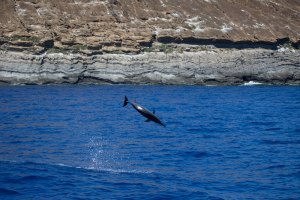Protecting Spinner Dolphins
Holo Holo Charters has voluntarily participated in NOAA’s Dolphin SMART program for over a decade. We feel it’s our privilege and responsibility to protect the marine life and fragile ecosystems we enjoy everyday. The Dolphin SMART program is in place to promote responsible stewardship of wild dolphins in coastal waterways.
Unfortunately, not all tour operators think like we do and the disruptive behavior of vessels has impacted the quality of life for many marine animals. NOAA has now issued new regulations to better protect the Hawaiian Spinner Dolphins who frequent our waters.

Why is NOAA Fisheries establishing these regulations for Hawaiian spinner dolphins?
Unauthorized take of marine mammals, including harassment of spinner dolphins, is prohibited under the Marine Mammal Protection Act (MMPA). However, despite prohibitions, guidelines, outreach, and stewardship efforts currently in place, close interactions between humans and spinner dolphins continue to occur in waters around Hawai‘i. These interactions are especially prevalent during Hawaiian spinner dolphin essential daytime habitats. Based on the best available scientific information we have determined that additional regulations are required to protect Hawaiian spinner dolphins from activities that result in take, including harassment or other forms of disturbance as currently defined by statute and regulation.
